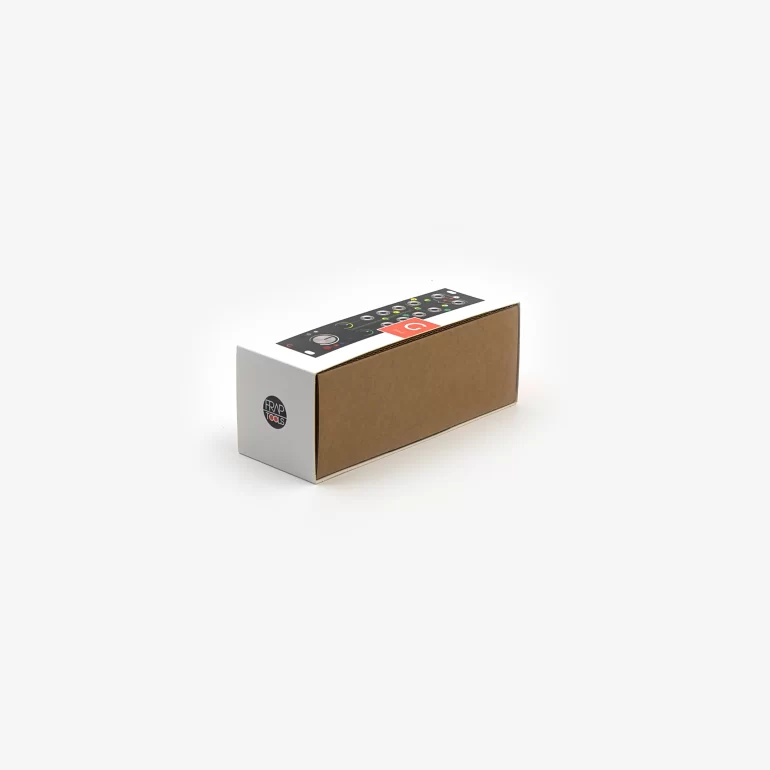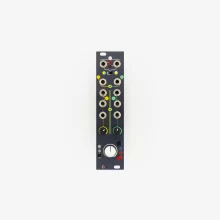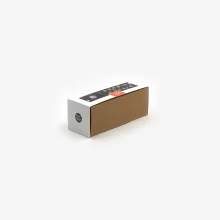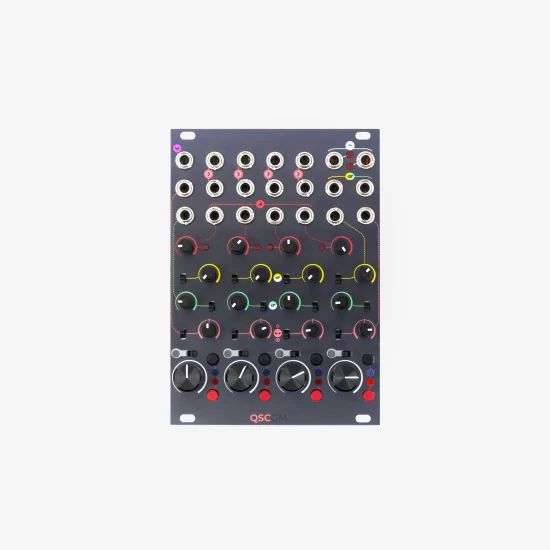Description
The group is a stereo module that blends the signals coming from the channels linked to it (up to eight) and manages their signal routing.
The group “puts into practice” all the information defined by the channels’ controls: volume, effect send volume, and stereo panning.
It consists of three sections: the amplitude controls (white) and the two effect sends and returns (yellow and green).
A switch lets you define the group outputs’ behavior: it can be either the sum of all the channels and their effect return or just the wet signal.
The first option is great for smaller setups, where you can use the group as your system’s output without a master module.
Should you have a master, the second option allows for more advanced effects parallel processing or multitrack recording.
Key Features
The group has two independent monophonic outputs and stereo inputs to create effect send/returns. (The mono output signal is the sum of all the channels’ send levels.) A CV over the stereo return level allows you to automate the effect section, like for gated reverbs, but also to use the stereo return as an auxiliary stereo channel.
Two outputs (left and right) provide either the local sum of all the channels connected to the group and their effect or just the wet sounds (for further parallel processing). A jumper on the back selects the behavior.
The mute button allows you to remove a group from the master sum with a click. The mute doesn’t affect the local outputs: in smaller systems, where a group is the output module, it prevents accidental muting; in larger setups, it keeps the local outputs active for creative parallel processing.
The switch lets you solo a “scene” of prepared channels set up through their solo-in-place buttons or switches. It can be seen as a mute group function that allows you to mute all the channels outside the solo scene with a click.
The PFL button routes the group to the master’s PFL section, allowing you to pre-listen the whole group when muted or with the fader all the way down.
Two peak LEDs show when the group is clipping. However, don’t be shy! You can clip the group on purpose and enhance your sound, either with a creamy saturation or a significant distortion.
Group Family Comparison
Local output | Stereo | Stereo |
Local output sources | Post-fader local mix/FX returns | Post-fader local mix/FX returns |
Local output source selector | Jumpers on the PCB | Mechanical switch on the front panel |
FX send/return circuits | 2 | 2 |
FX send | Mono | Mono |
FX return | Stereo | Stereo |
CV over FX return | 2 | 2 |
Mute | Mechanical latching | Electronic latching |
Safe solo | Mechanical latching | Mechanical switch |
PFL | Mechanical latching | Electronic latching |
Fader knob | ⌀ 20 mm | ⌀ 12 mm |
Learn
Learn
Learn
Additional information
| Weight | 0,161 kg |
|---|---|
| Dimensions | 15,6 × 6 × 6 cm |
Specs
Size | 6 HP |
Depth | 38 mm |
Current draw | 60 mA @ +12 V 60 mA @ -12 V |
Recommended warmup time | 30 min |
Audio input impedance | > 10 KΩ (mono) > 20 KΩ (stereo) |
Audio output impedance | ≥35 Ω |
CV Input impedance | > 90 KΩ |
Maximum output level before clipping | ≥ 17 dBu |
Output gain scale referred to C and SC | 6 dB |
Output gain scale referred to QSC | 0 dB |
Return to G output | 12 dB |
Frequency response | 0.01 to 40 KHz |
Harmonic distortion | < 0.3 % |
More details on the Manualone.
FAQ
A. Use
Our modules are packed with high-quality components that demand a proper power supply and can get sensibly warm.
That is its normal temperature and we can guarantee their performance.
You always need at least one group if you plan to incorporate a master module in your setup. It is not possible to connect any channel module directly to a master module.
The CGM is designed to let you connect up to eight channels (C or QSC) to one group (G), but there is no way of connecting the same channels to two or more groups.
Yes, to take advantage of the Master module’s functions (PFL, headphones, final gain stage), you need at least one group.
We designed the group (G) module together with the classic mono channel (C), which is 6HP wide. After the QSC release, we developed a new Link System with wider plugs that allow you to connect more QSCs in a row.
If you need to connect more QSCs, check your local shop for cable availability!
If you just need to connect a QSC, the classic group-to-channel cable works great, too.
If you experience an abnormal panning on the CGM, check your case’s power supply and your system’s overall power consumption. We experienced that the CGM system sometimes has trouble working in a system close to its maximum Ampère output. An unbalanced power supply may cause the audio to be louder on one channel than on the other.
Try staying below 80% of the total amperage or switch to a more powerful PSU to solve this issue.
The Mute button closes the first VCA of the channel, thus preventing the sound from being routed through all the other VCAs (FX sends, pan, main fader).
The Solo in Place button isolates some channels and mutes the others. However, the mute function it performs is different since it affects the channel after the fader: the sound will still be routed to any pre-fader VCA such as Direct Output and FX Sends (when set to Pre-Fader Mode).
In other words, the Mute button works pre-fader, while the Solo in Place works post-fader.
B. Design
We have two main kinds of capacitors.
The first one is necessary to AC-couple the audio signal: they prevent any unwanted DC offset, and they offer protection against wrong connections. For this reason, you can patch nearly every input to every output, and the worst thing that can happen is some pops or some silence.
The second one is power filters to guarantee a cleaner current flow across the case. They might sound a bit over the top, but we must remember that a Eurorack system is not something that comes straight out of the factory. Instead, every Eurorack setup is unique and may change according to the musician’s need. For this reason, we want to add as much protection as we can, both to avoid issues with our modules and to ensure that even the other modules behave correctly. We use a wide mix of capacitors in our modules: ceramic, electrolytic, tantalum, and multilayer. They can be assembled thru-hole or SMD, according to what gives the best balance between result and space. For example, all the electrolytic capacitors are mounted thru-hole because they perform better according to our tests.
However, the capacitors have zero impact on the power draw, on which you can read in this other FAQ.
Power draw should always be related to what a module does.
Generally speaking, there are modules like SAPÈL that undoubtedly consume more than other random generators. However, SAPÈL is a double module, so a fair comparison would be between it and a pair of similar modules. The same can be said for FUMANA, the most power-demanding filter bank. However, it is also the only Eurorack filter bank with 32 analog bandpass filters, half of which have a 48 dB/oct slope. So, also in this case, a fairer comparison would be between FUMANA and TWO other 16-band filter banks, which leads to similar power consumptions.
More in detail, we engineer our modules to be safe to use. To protect both the modules and the rest of the case, we add a proper buffering stage to every input and output: even if a single buffer doesn’t draw that much power, all the ins and outs piled together can significantly impact the final power draw.
C. Shop
Yes! We opened our online store in October 2022. Check out the full catalog!
Our resellers receive our modules exclusively through our distributor, so we do not have access to the individual shops’ orders or stocks.
We restock every module at least once over a year: we focus on a module’s batch at a time, then we move on to the next one, and so on.
If you want an estimated delivery time for a specific module, drop us a line! We’ll be happy to answer you.











